
What is a Brain?
I typed up my behavioral neuroscience notes from college and tried to make the more entertaining. This is more for housekeeping & testing out my blog hosting software than content but… enjoy!
tldr at the bottom
Our Mind-Body Connection 5. Hormones: Brain-Body Communication 11. Homeostasis: How we keep our internal environment stable 10. Motor System: How we move
Neural Nights 12. Sleep 13. Memory
Let’s dive into…
Neuroanatomy: Anatomy of the Brain
Quick note before we get started:
- The brain is super complicated with a laundry list of parts + regions
- Scientists like to make up fancy words so they sound smart
- Anatomy, especially neuroanatomy, is about learning these made-up words so you can talk about very specific areas of the body.
In short: There is going to be a lot of vocab in this section. I’m sorry.
Unless you have a test on this subject, I don’t recommend memorizing anything. Getting the general idea of how things work is much more important than remembering the difference between the Superior Colliculus and Inferior Colliculus.
I will also try my best to cut out as much medical jargon as possible. I think it distracts from understanding the fundamental concept of neuroanatomy, which is:
How is the brain structured?`
We are going to start as general as possible and quickly work our way down to neurons, the building blocks of the brain.
Parts of the Nervous System
Like it sounds, the Nervous System is a collection of connected nerves that helps the body communicate with other body parts. The brain is central to this communication. The Nervous System is made of:
-
Central Nervous System: Anywhere in the body with nerves that are encased in bone:
- Brain
- Spinal cord
-
Peripheral Nervous System: Anywhere in the body with nerves that are not encased in bone:
- Nerves leaving brain or spinal cord
- Nerves connected to internal organs
Brain Material
The brain itself is made up of:
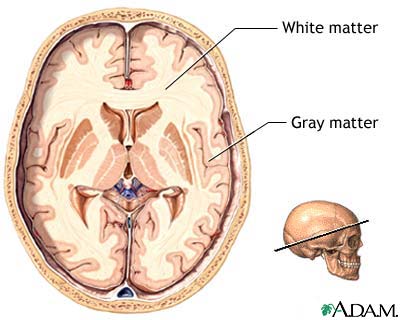
- Grey matter: Neuron synapses (connections) and cell bodies found along the “outside” of brain
- White matter: Mylinated (fat-covered) cells found “inside” the brain
The brain floats in a liquid called Cerebral Spinal Fluid (CSF), which acts as a shock absorber.
The brain is protected by bone and the meninges, membranes covered in pain receptors. This is where the word meningitis comes from, and why meningitis hurts so bad.
There are also 4 pockets of CSF fluid “within” the brain called ventricles.
Brain Lobes & Cortices
There are four brain lobes, named for the bones overlying the skull. The names are quite poor and don’t actually reflect their function, but roughly:
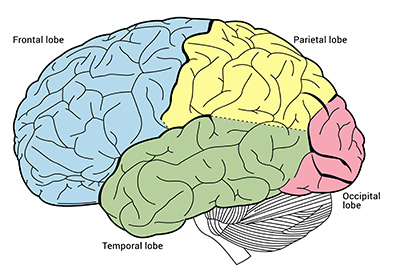
- Occipital Lobe: Back of brain. Home of visual system
- Temporal Lobe: Left side of brain. Home of auditory system
- Parietal Lobe: Top + Right side of brain. Home of body representation and movement
- Frontal Lobe: Front of brain. Home of planning and higher processing
While the brain lobes are quite popular, they are not the most accurate way to understand brain areas. A better representation can be seen in the sensory cortices:
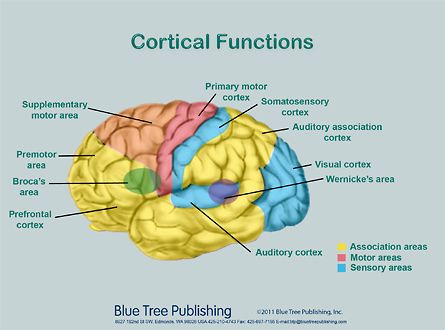
As you can see from the above image, some brain regions have helpful names like Visual Cortex and some are named after scientists who really wanted to be famous like Broca’s Area. We will breakdown these cortices during our Tour of the Nervous System.
Neurons
Neurons are made up of 4 parts:
- Dendrites, which receive neuron inputs
- Cell Body, which integrates all inputs
- Axons, which transports signal to neuron endings
- Synaptic Terminal, which outputs signal
When talking about neurons, it is important to keep in mind the scale of things– specifically how unbelievably small they are.
- Neuron cell bodies are 10 microns in length, or 1/100th of a millimeter
- Synapses are 1 micron in length, or 1/1000th of a millimeter
- Synaptic Clefts are 10 nanometers, or 1/1000th of a nanometer
For a better visual- the head of a pin is 1.5mm. On a single pin head we could fit…
- 150 neurons cell bodies
- 1,500 synapses
- 1,500,000 synaptic clefts
We have 100 billion neurons in our brain.
To put this in perspective– 100 billion seconds is roughly 3,170 years.
If laid down in a straight line, our neurons, despite being so small you can fit 150 on the head of a pin, would stretch 1000km (621 miles).
Neurons are minuscule in size, and we have an astronomical amount of them.
One day I’ll generate a sense-of-scale video in Blender to show here…
The Axon
Axons are the roadways between neuron inputs and outputs. While the dendrites, cell body, and synaptic terminal stay relatively the same size, Axons can extend to pretty huge lengths. Like across the entire brain. Or up the entire spinal cord.
Transporting signals this long of distance is hard, and signals can easily get lost or take too long to reach their destination.
To ensure signals are not lost, axons are covered in myelin, or a layer of protective fat.
To ensure the signal can travel fast enough, the layer of myelin (myelin sheath) is broken up with exposed pieces of axon. The “exposures” are called Nodes of Ranvier.
Electrical signals can “jump” between Nodes of Ranvier instead of travel up the entire axon, helping them travel much faster.
The Synapse
Synapses are the endings of synaptic terminals, and are how signals are passed between neurons. The space between neurons is called the synaptic cleft. Tiny bubbles called synaptic vesicles dump even tinier chemicals called neurotransmitters into this cleft, which are then absorbed by receptors on the neighboring neuron (dendrite).
The communication between neuron is fundamental to neuroscience and we will revisit the synapse soon, this was just to familiarize yourself the anatomy/vocab.
Transport & Cleanup
To stay clean, neurons have to both transport new cell parts up to the synaptic terminals (Anterograde Transport) and cleanup old cell parts from axon (Retrograde Transport)
Glial Cells, amongst other things, are specialty cells that help with cleaning and transport. There are four types:
- Astrocytes: Maintain neuron homeostasis by supplying/taking away neurotransmitters.
- Oligodenricytes: Produce myelin for cells in Central Nervous System
- Microglia: Immune system of the brain. Grow large (macrophages) and “eat” foreign bodies
- Schwann Cells: Produce myelin for cells in Peripheral Nervous System
Tour of the Nervous System
Everything has to do with your nervous system -Jonathon Lipnicki
The fundamental concept of this section is:
How does the Nervous System work?
We are going to structure our tour of the nervous system by separating neuroanatomy into 3 categories: Input, Processing, and Output
Input: How signals are first generated
Most signals enter the nervous system through nerves (duh) which are a collection of axons that carry information to and from the CNS.
There are 12 cranial nerves which carry information about senses in the head and internal organs.
Spinal Nerves carrying sensory information enter the CNS through the Dorsal Root, which is a fancy word for the back of the spine. Motor information exits the CNS through the Ventral Root, or front of spine
All sensory inputs (except smell) then travel to the Thalamus, the post office of the brain, to be distributed to appropriate brain region.
Processing: How signals are interpreted
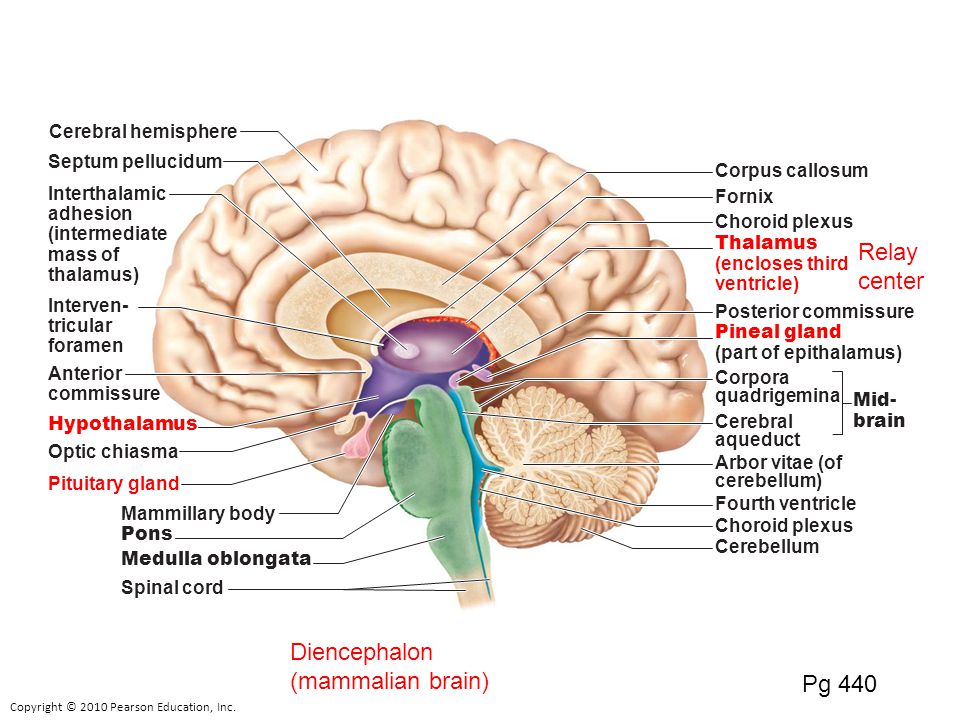
As the above picture shows, there are a lot of brain regions. If you want to memorize all of them, eat your heart out.
Otherwise, I’ve chosen to highlight the three most important (in my opinion) areas:
Cerebral Cortex The “wrinkly” part of the brain that wraps around the outside. It is essentially a 2-D sheet, with a depth of only about 4mm. It is responsible for perception, learning, memory, planning, and decisions. Also 40% of the cortex is dedicated to vision.
Cerebellum The back-bottom of the brain that looks separate from the wrinkly cerebral cortex. It is responsible for reconciling sensory and motor maps, synaptic plasticity, and motor coordination.
Brainstem Comprised of the midbrain, Pons, and Medulla. Often called the “Reptilian brain” because it is older and deals with more fundamental processes.It is responsible for breathing, heart rate and pressure, eating, and sexual arousal.
Output: How the body responds to signals
The literal output of the nervous system comes in the form of a memories, hormones, and behaviors. While later posts will deal with these outputs more in depth, right now we will briefly go over a few key structures:
Limbic System
Primary Structures are:
- Hippocampus: Deals with transferring short-term memory to long-term (not where memories are stored however). I’m sure you’ve noticed that attention, smell, and emotion have a particularly strong effect on memories. This is because the structures responsible for those attributes (Cingulate Gyrus, Olfactory Bulb, and Amygdala respectively) are closely wired to the Hippocampus.
- Hypothalamus: Regulates hormone levels in the body. Also controls the Autonomic Nervous System (see below)
Autonomic Nervous System
An automatic response system that spans both the CNS and PNS. It is broken down into two parts:
- Sympathetic Division: The “fight or flight” response in the body. It is found in the middle of the spine (Thoracic and Lumbar) and releases hormones throughout the body. If you’ve ever been scared, you have activated the sympathetic division of your autonomic nervous system
- Parasympathetic Divison: The “rest or digest” response in the body. It is found at the top and bottom of the spine (Cranial and Sacral) and releases hormones in targeted areas very close to organs.
Development: How Brains Grow
First, before we discuss how our brains develop, we should answer the question: Why are our brains so special? Why are human brains so much better than other animals? Answer:
We are not Special.
Human brains are not as special as we like to think…
- Humans share very similar brain & brain cells structure as most vertebrates
- Humans share ~ 98.5% of our DNA with chimpanzees… and 60% with bananas
- Humans don’t have the biggest brains (whale)
- Humans don’t have the heaviest brains (also whale)
- Humans don’t have the most brains (leeches, with 32!)
- Humans don’t have the highest brain-to-body ratio (ants, shrews, and small birds all have 10 times higher ratios)
- Humans don’t have the most neurons (Octopi have 5x neurons on us)
- Humans don’t have the most synapses (Elephants)
What we do win at is the Encephalization Factor, which is “the ratio between actual brain mass and predicted brain mass for an animal of a given size.” (I think it was made up to help human brains win at something…)
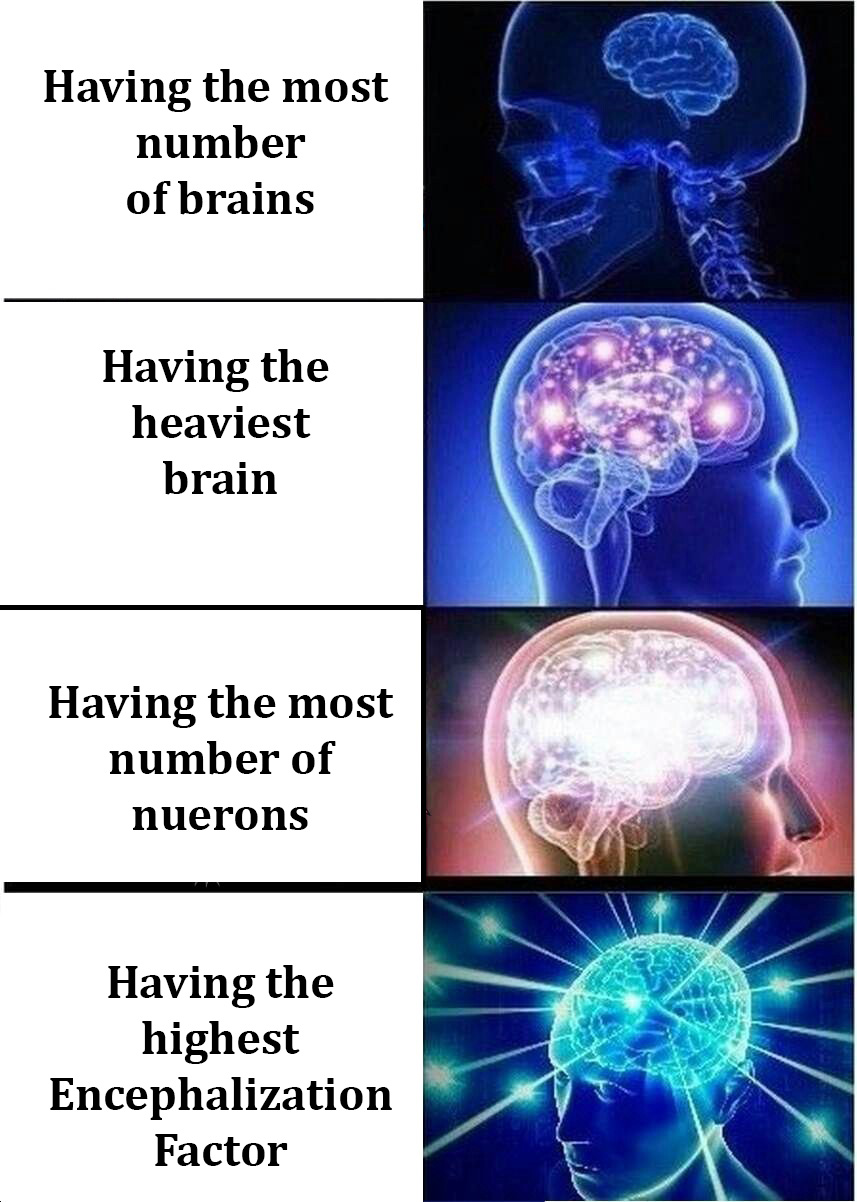
Most big differences between species’ brains are due to an individual species adapting to their environment. Animals that rely heavily on sense of smell have much larger/complicated olfactory brain regions, those that rely on hearing have larger hearing brain regions, etc. We rely on our vision quite a lot, so we have a very large visual system. What we also have is a very large critical thinking area of the brain– unmatched in the animal kingdom. Current theories as to why this adaptation occurred (and this is still a hotly debated topic) is because Humans are incredibly social creatures, and socializing is a complicated process that requires a large amount of critical thinking power behind it. This push to be social early in our evolution may explain why our brains are the way they are.
Brain Development
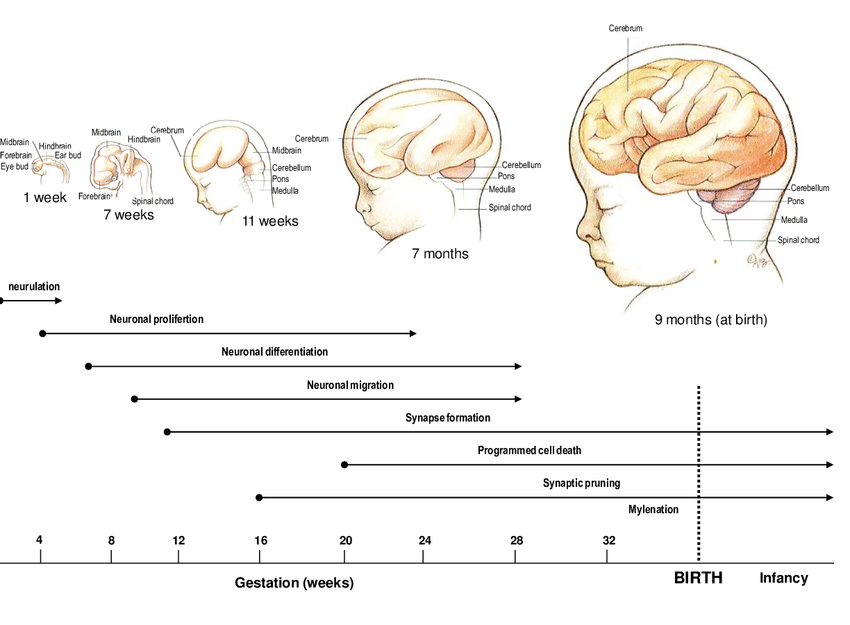
Humans start off as a zygote, or fertilized egg, and then grow into a blastocyst, or ball of dividing cells. Blastocysts can be generally broken down into three cell layers and one of these layers, the Ectoderm, will develop into the Brain and nervous system. From this step there are six stages of brain development, each covered below:
- Neurogenesis: Brain cells are produced from stem cells and group together in the ventricular zone
- Cell Migration: Brain cells start to move away from the ventricular zone by crawling up radical glial cells which act as “ladders” spanning the length of the cortex. Brain cells start forming layer on top of layer until there are 6 layers of cells
- Differentiation: Cells start to specialize into neurons or glial cells. Unlike animals with a smaller number of neurons, Human neurons maintain a more flexible differentiation is determined by cell-by-cell interaction, or the influence of a cells specialized function on its neighbor’s decision. This is partially why brain imaging/procedures/etc. are hard to generalize—everyone’s brain regions are slightly different in size/shape
- How do neurons know where they are in the brain? No definitive answer Current theory is that growth cones, found at the tips of axons, grow towards chemoattractants released by nearby cells of a similar system. In this way they understand how close they are to a particular system, and specialize to this degree; the closer they are to the heart of the system, the more they specialize
- Synaptogensis: Synapses between neurons start to rapidly form in the largely unwired fetal brain. Nerve cell bodies increase in size to support the growing synapses
- Apoptosis: Dramatic, but normal, guided cell death. 20 – 80 % of cells die; your body simply doesn’t have enough Nerve Growth Factor (NGF) to support that many brain cells. NGF is simply the name for substances needed for cells in the nervous system to grow. Apoptosis should not be confused with Necrosis, which is cell death caused by lack of NGF seen in malnourished fetuses, which is more severe and uncontrolled.
- Cells have death genes that become expressed during apoptosis. This expression is first triggered by an influx of calcium into cell, which leads to the release of the Diablo protein from the Mitochondria. Diablo inhibits IAPs, Inhibitor Apoptosis Proteins, which then triggers the activation of Caspases, proteins that rip apart DNA and proteins, which signals the beginning of apoptosis.
- Synaptic Rearrangement: Remaining neurons stake advantage of newly opened synaptic space to create more complex connections. Since the connections that survive apoptosis are the most important, while neuron density falls during development, neural activity stays constant. Throughout these 6 steps myelin is being formed around important axons. Sensory zones are myelinated before motor zones, leading to quicker sensory processing than motor control as a baby.
tl,dr;
- The Brain is part of the Nervous System, basically our system that receives and responds to stimuli
- Understanding the basic concepts is more important than memorizing the vocab
- The Human Brain has no obvious advantage over other brains.
- Our brain develops by producing layers of neurons, which soon specialize to a flexible purpose.